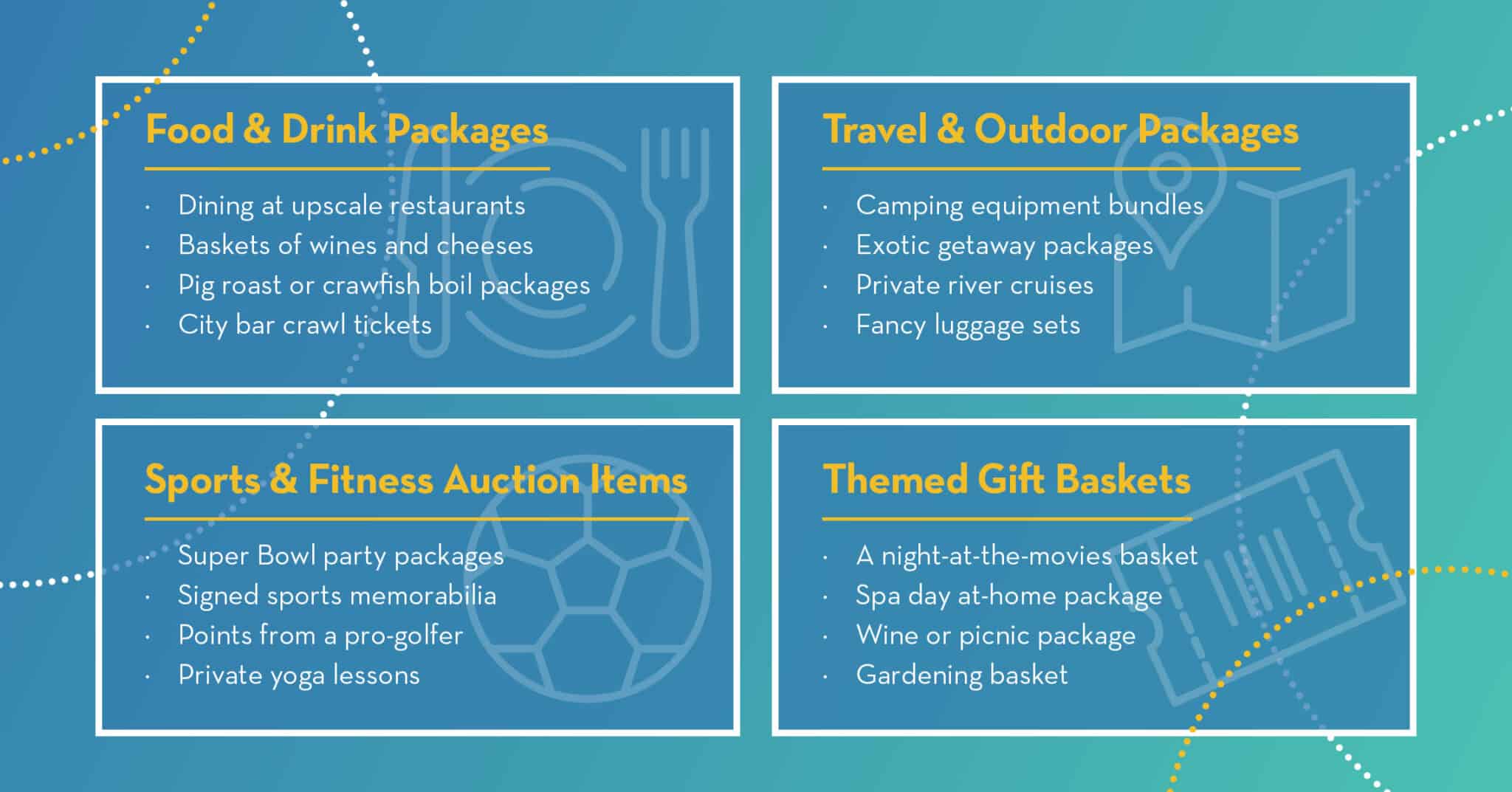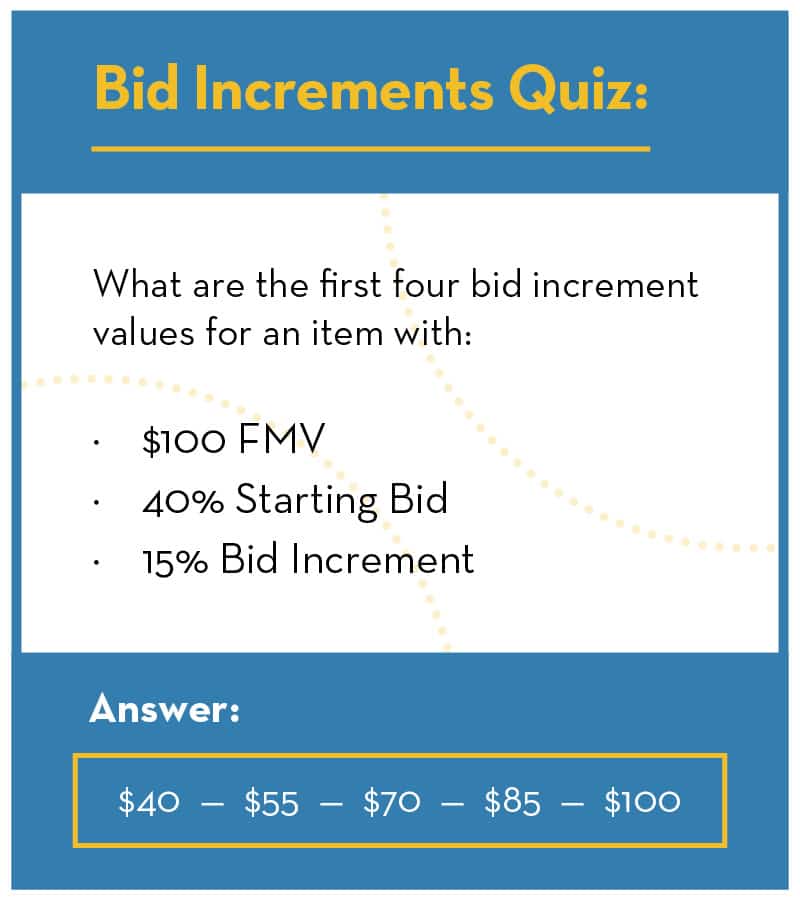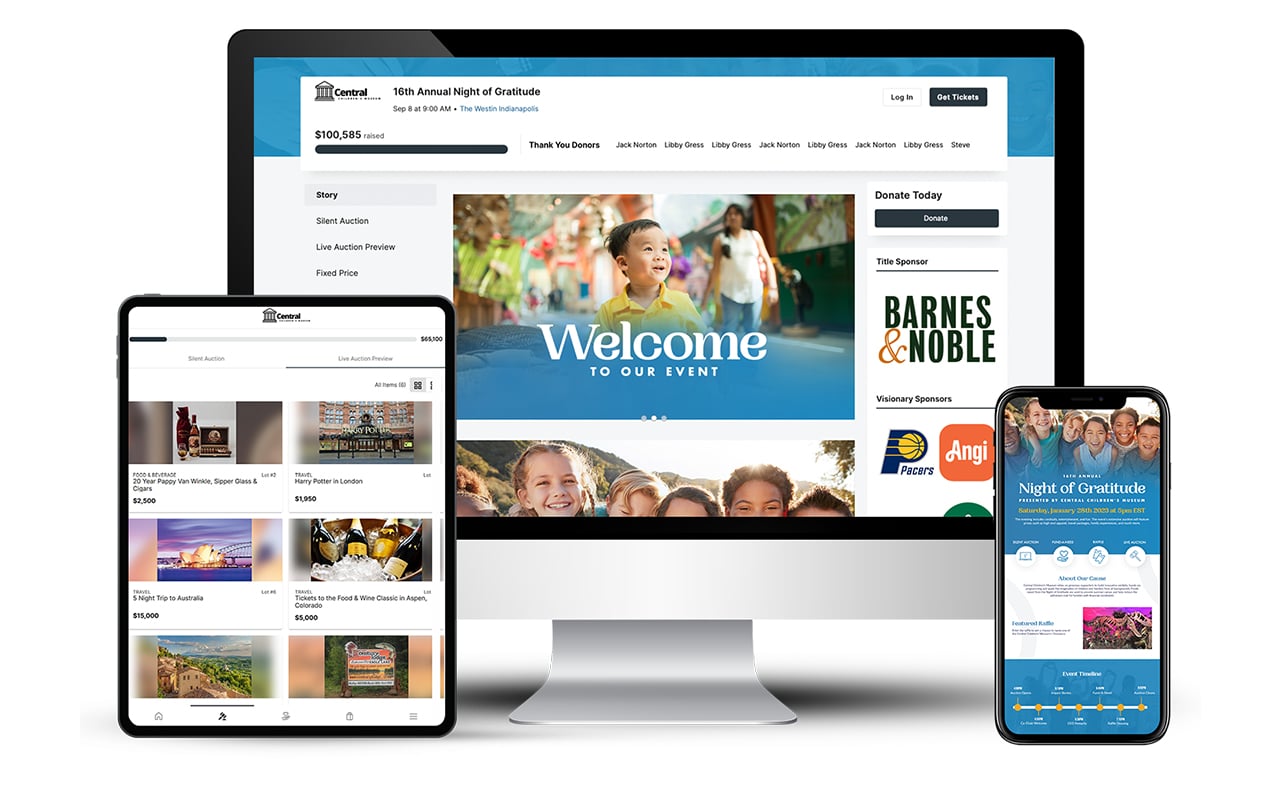13 Silent Auction Strategies: The Ultimate Guide for Nonprofits
Silent auctions prove to be an effective fundraising strategy time and time again. They are a great way to maximize donations at a gala, cocktail fundraiser, school event, golf tournament, and more.
When it comes to planning a silent auction, you need to make sure your event stands out from the rest. We created this ultimate guide so you have the top silent auction strategies for your next event!
In this resource, we’re diving into:
Choose the Right Silent Auction Items
What’s a silent auction without the perfect silent auction items for your guests? While there are plenty of items you can choose to include, there is no secret formula to which items your organization should offer at your silent auction.
Most of item procurement is dependent on what your guests want and what your procurement committee can secure! When trying to choose the right silent auction items, here are a few strategies you can use to hit the ground running:
1. Form a Procurement Committee
To meet your fundraising goals, you need to “wow” your guests with your silent auction items. First, create a team whose only job is to solicit auction items. This team should start procuring items 9-12 months before the event, allowing plenty of time to secure the variety of items needed to entice your auction crowd.
To create an amazing procurement committee, look for individuals who are:
- Willing to ask: While this may seem simple, most procurement committees will have members who are timid about asking for donations, especially at first. These individuals must feel confident in the pursuit of high-quality item donations.
- Well-connected: Individuals that are connected within your community are priceless. The more people they know, the greater your nonprofit’s reach will be. Well-connected people are key to finding unique, desirable items that will spark top dollar bids.
- Organized: Silent auction item procurement takes persistence. You won’t get a “yes” every time, so organization is key. With the need for consistent follow-ups, members must be able to keep track of their solicitations and responses.
- Available: There’s no denying that item procurement is time consuming. Individuals who join this committee will need to fully understand their role in the silent auction process and the time commitment they’re agreeing to.
This committee will have the sole responsibility to solicit desirable, unique items that cost little to nothing and will drive ticket sales and bids. Choose the right individuals set your auction up for success!

2. Review Past Silent Auction Performance
If this isn’t your first silent auction event, it’s important to take a look back before taking a look forward. Prior to planning this year’s event, review your past silent auction item performance.
Keep an eye out for:
- Which items had the most bids?
- Which items had no bids?
- Which items met or exceeded their value?
- Who donated those popular items?
By looking at past performance, you can get a clue as to what kinds of items were most popular with your audience and what items you should begin to seek. Those are likely to sell well again.
Don’t forget to keep things interesting for your donors. Coming back to the same items year after year will make for a dull silent auction. Try bringing back the items that were wildly successful and then add new items that fit your donors’ interests and current trends.
3. Identify Items that Excite Your Donors
Silent auction items can be the most important revenue element of your event. After all, when the right items are on the table, they become the main attraction for the evening and can create a fundraising frenzy! A good silent auction will energize your attendees and maximize donations – not to mention drive fundraising.
Keep in mind that the best silent auction items tend to:
- Align with your supporters’ interests. The more your items match up with your supporters’ passions and hobbies, the more bids you’re going to see.
- Fall into your supporters’ general price range. Keep your supporters’ general price range in mind to ensure they’ll have the capacity to bid on the items available.
- Offer something unique. If someone only has one chance to win a rare and one-of-a-kind item, they’re not going to be able to resist placing a bid!
- Take advantage of hot trends. Your team should jump on any items that are hot, new, or trendy. Offering the latest and greatest items is sure to drive bids at your event.
When identifying what auction items would excite your donors, think about your event audience! Young couples? Retirees? Art lovers? Sports Fans? Wine lovers?
Once you know your audience, turn your procurement committee’s focus to finding items and services that fit those interests. For example, if your audience is full of wine lovers, tickets to a local winery or a Napa Valley trip could be seen as desirable items that are sure to sell well.

4. Create Your Item Wish List
With the help of your procurement committee and armed with what you know about your audience, brainstorm what silent auction items will take your event to the next level. The outcome will be your silent auction item wish list.
Here are key questions to get your brainstorming going:
- What local entertainment venues do your donors frequent?
- What are your donors’ go-to restaurants for a night out?
- What sporting events are going on in your area?
- What hobbies do your donors have?
- What access do you have to special experiences?
Encourage every idea, no matter how out-of-reach or unusual they may seem. You never know awesome auction items will come of it! Here are a few ideas to get you started:

5. Write Powerful Donation Request Letters
While making a wish list is an important step in the process, requesting these silent auction items is where the real work comes in! Silent auction donation request letters can help.
Donation request letters are essential for building your auction. The letters are the first introduction to individuals and businesses that you’re having an event, need silent auction items, and want to offer them recognition and visibility as a part of their support. So, make it count!
When writing a donation request letter:
- Address the decision maker
- Acknowledge your donor relationship
- Begin storytelling
- Provide a call to action
- Explain the benefits
- Invite them to the event
- Thank your donor and sign
- Provide a donation form
A powerful donation request letter will be the perfect asset to your procurement committee. After all, the less money you have to spend on bringing in great items, the greater the return on investment will be for your auction. And that equals more money to power your mission!

Price Your Auction Items Effectively
Pricing your silent auction items can be a daunting task, especially if you don’t know where to begin. But with the right pricing strategy, you can determine prices that will spark high interest and ignite competitive bidding. Here are a few ideas to help you get the right pricing strategy in place:
6. Determine the Fair Market Value (FMV)
Determining the Fair Market Value (FMV) of your items will determine your pricing strategy for each item. The FMV is the estimated value of an item based on similar products in the market and is an important reference point when determining a starting bid.
Determining FMV comes in two forms:
- Tangible items: These items are typically easy to price because there is a concrete value to the product or service. A $25 certificate to a restaurant in down would simply have an FMV of $25. Most tangible items for your silent auction will have prices that you can easily find online with a little research.
- Intangible items: These items require less online research and more of an estimation based on what you believe your guests are willing to pay. Think of your donors’ demographics, income, and relative interest in similar items at previous events in order to come to an educated decision.
For tangible items, keep in mind the actual “dollar value” of an item can be worlds apart from what a buyer is actually willing to pay. For intangible items, remember that this price is based on what your guests will be willing to pay – not what you would personally be willing to pay.
If you are still struggling to come up with a number, ask a few of your top donors for their input. Involving them in the planning process is a great excuse to chat about the event and get them excited about what’s to come.
7. Identify a Starting Bid
Setting a starting bid for your silent auction items requires a clear strategy. Ultimately, it’s a balancing act. Base your decision on data – what has performed well? What were the previous starting bids?
If the starting bid is too low, you can miss out on potential proceeds. If the starting bid is too high, you may lose out on competitive bidding between donors.
But don’t let that intimidate you — there are a few best practices to help you estimate the starting bid for your silent auction items.
It is industry best practice to set minimum bids at 40-50% of the FMV. This range is low enough that it sparks a great deal of interest from donors, but it mitigates the risk of your organization losing out on the potential of a large donation from the starting bid being too low.
There are reasons, though, that your starting bid may be out of this 40-50% range:
- The item performed well in the past: Items such as prime parking spaces or unique experiences that have performed well in the past may call for a higher starting bid.
- Your audience is used to the 20-30% range: If your audience is used to lower starting bids, don’t give them sticker shock! Make gradual increases year over year until you reach the 40-50% range you’re looking for.
- Your audience demographics: You know your audience. If the best practice of 40-50% is out of their price range, you’ll lose out on participating bidders. Always keep in mind it’s ultimately what your guests are willing and able to pay.
Ultimately, the minimum bid price is up to the discretion of your organization. Don’t forget, just like most things in the world, your prices should go up year-over-year! Don’t be afraid to implement a small increase. It could take your proceeds to the next level.
8. Set Bid Increment Guidelines
Minimum bid increments can greatly impact on how well your silent items perform. For example, you don’t want your attendees putting down a $5 bid increase on an item like an iPad – you’ll never reach your goals! But you also don’t want to enforce a $500 minimum bid increment – you’ll lose out on bids! We’re here to help you put a strategy in place.
It is industry best practice to set minimum bid increments at 10-15% of the FMV. For example, if an item has an FMV of $100, the starting bid for the item would be $40. When the first bid is placed, guests will have to make a bid of at least $10 or more in order for the bid to be valid.
There are additional variables to consider when choosing bid increments:
- Items with a high price and low popularity: If an item is expensive but not highly desired by your guests, it may need a lower minimum bid increment set.
- Items that haven’t performed well in the past: If the item didn’t meet expectations in the past, consider lowering the minimum bid increment.
- Items that incite bidding wars: If an item is popular among guests, don’t set the minimum bid increment too low! Maximize the effectiveness of the silent auction and maximize the proceeds for your organization.
Determine what bid increment will allow for the most bids and most proceeds. Then roll with it!
9. Offer a Buy-It-Now Option
Instead of having your attendees come back to bid on an item time and time again, you can offer a Buy-it-Now option, so your bidders have the ability to buy the item immediately. This option appeals to individuals who are certain they want that item and are willing to pay top dollar to get it right then and there.
If your item can be sold as a Buy-It-Now – do it! You can do this by placing the Buy-it-Now option at 150-200% of the item’s FMV. Try it, these items can be a win-win for you and your bidders!
You won’t want to offer this option on every item, so be strategic about which ones you choose to setup as a Buy-It-Now. Items that should not have a Buy-it-Now option include:
- Items with high emotional appeal
- Unique or one-of-a-kind items
- Experiences you can’t find anywhere else
- Items that have started bidding wars in the past
Be sure to advertise your Buy-It-Now strategy before and during your event. The more attention you can draw to the items, the greater the sense of urgency for bidders.
These purchases are often impulse buys, which can be incited through your auction communications. Or, if you have a charity auctioneer, make announcements about this option throughout the night.

Inspire More Silent Auction Bids
Your team puts an incredible amount of effort into getting the perfect items for your silent auction and strategically pricing them. Here are a few sure-fire strategies to encourage more bidding activity:
10. Use Mobile Bidding
Gone are the days of guests walking around to each item to continue placing bids on paper, never knowing if or when they’re going to be outbid and lose out on an item that they were originally willing to pay top dollar for.
When you’re looking to inspire more silent auction bids, mobile bidding is your answer.
Mobile bidding allows your nonprofit to put the auction in the palm of every donors’ hand. Nonprofits typically see 60-65% more bids when they switch from paper bid sheets to mobile bidding! The result is an elevated guest experience and shattered fundraising goals.
Why use mobile bidding?
- Donors are online – it’s convenient.
- Bidding is as easy as clicking a button. Donors are then more inclined to participate.
- Bidding wars frequently occur because individuals can outbid one another right from their seats without having to travel back and forth to a bid sheet.
- As the world becomes more technology-centered, donors are acclimated to the processes of online bidding and fundraising.
- There’s universal access.
- Mobile bidding is just that – mobile! It’s ran completely online, meaning donors can participate in your silent auction from anywhere.
- Opening up your auction to more supporters than just your attendees naturally results in more bids, and therefore more proceeds raised.
- Bidding is open longer.
- Using mobile bidding means you can open your silent auction before the event even starts with pre-bidding.
- Pre-bidding builds excitement for your guests to see what items are available and allows for your team to walk into the event with bids already placed.
- Since you’ll have fewer logistics complicating your night with check-in and check-out, your organization can keep bidding open for as long as possible.

Take a tour of OneCause to see how we can help streamline your auction!
11. Utilize Gamification
The goal of any silent auction is to get the most amount of people to participate. More participation means more bids, and more bids means more proceeds for your cause!
Gamification can take participation at your event to the next level, and it can be incorporated in your event in many different ways.
“Gamification” is the application of game elements into activities that are not typically game-related. This silent auction strategy creates interest, increases competition, and provides incentives for participation at your event.
Thermometer
Having a thermometer displayed at your event gives guests real-time updates and keeps the energy up. They can go a long way to encourage healthy competition and remind guests that the purpose of the event is to raise money to support your organization’s mission.
Out-bid Notifications
It’s easy for attendees to get distracted from bidding. If donors don’t keep their eyes on the silent auction bid sheets at all times, they might miss being outbid!
With mobile bidding, your supporters can stay connected to the auction with automated outbid alerts. This means if another donor places a higher bid on the same item, donors receive an instant notification via their mobile phone. They can click the notification immediately and quickly place a counter bid or Buy-It-Now.
Your bidder can even set a maximum bid amount within their budget and sign up for automatic bidding – giving your guests more time to socialize or bid on even more items!
Countdowns
We’ve all seen it before… a silent auction starts out strong but then fizzles out as donors forget about placing bids. This results in lower bids and ultimately lower revenue. Don’t let it happen at your next event!
Set a countdown clock and put it on display at the event and on every bidders’ mobile phone, letting them know exactly how much time is left in your silent auction. Keep the auction top of mind by using the auction countdown ticker and watch bidding gamification give your proceeds an extra boost during the final bidding spree.
In Event Messaging & Texting
Finding a way to communicate with your guests during your event is essential to driving more bids in your silent auction. Think about messages that will boost your proceeds or provide direction to do so without explicitly telling guests “bid more!”
We’ve found that the best reasons to text your guests include:
- Letting them know silent auction is open.
- Identifying which items don’t have any bids yet.
- Warning them when the auction is about to close.
- Telling them where to pick up the items they’ve won.
Be strategic when your sending mass text messages to your guests. You don’t want to bombard them with too many notifications or distract them during key giving moments.

12. Bring your Auction to Life
Silent auctions aren’t as structured as live auctions or live appeals, so it’s easy for guests to become distracted as they’re eating, mingling, and enjoying your event. Bring your auction to life and be sure to make bidding the center of attention.
Actively engage your guests throughout the entire event. To keep your fundraising top of mind:
- Instruct your emcee to make announcements, give updates, and encourage bidding.
- Have bid assistants strike up conversations with guests and talk up items.
- Use an auction scoreboard that gives real-time updates about bidding.
- Show live feeds during event of people bidding and having fun.
By consistently drawing your guests’ attention back to the auction, bidding will always be at the front of their minds. That results in more bidding activity!
13. Be Strategic When Closing Your Auction
The final minutes of your silent auction are pivotal in reaching or exceeding your fundraising goals. Make sure your team is ready to ramp up the excitement and drive more bids when it comes time to close.
Here are some of our best practices for closing your silent auction event:
- Have a plan, but keep it flexible. Different elements of your event, like dinner or your live appeal, may run long. You never want to cut bidding short or close it out in the midst of a bidding war! Choose an estimated time to close it out but stay flexible.
- When it is time to close, have some fanfare around it. Have your emcee make an announcement, push out text notifications, dim the lights, crank the music, and let your guests know it’s time to get those final bids in!
- Don’t close it and then re-open it. This is the easiest way to frustrate your attendees who are eager to win an item. Put one person in charge of declaring when the silent auction will be closed and then stick to it.
These tried-and-true strategies are sure to lead your organization to an exciting event and shattered fundraising goals. What silent auction strategies do you implement at your events? Let us know by sending us an email at [email protected].
About the Authors: Melissa Merriam & Nicole Taylor, OneCause Consulting
 Over the past 15 years Melissa Merriam has helped Nonprofits succeed, first in sales and business development, and now, as Senior Director of Consulting and Training. She leads a high performing team of 35 Consultants and Managers to provide world class service and support to thousands of clients. Melissa is a creative problem solver and strategist and spends much of her time researching, connecting with customers and coaching her team to be the foremost experts in Nonprofit and event fundraising.
Over the past 15 years Melissa Merriam has helped Nonprofits succeed, first in sales and business development, and now, as Senior Director of Consulting and Training. She leads a high performing team of 35 Consultants and Managers to provide world class service and support to thousands of clients. Melissa is a creative problem solver and strategist and spends much of her time researching, connecting with customers and coaching her team to be the foremost experts in Nonprofit and event fundraising.

Nicole Taylor is a Consulting Manager at OneCause, supporting nonprofit partners during event planning with her expertise in industry best practices, as well as assisting in event execution as an event manager onsite. To fuel her passion for fundraising excellence, she has been helping nonprofits at OneCause since 2013 and has worked on over 600 fundraising events across the country.
Wrapping Up
- Silent Auction Pre-Bidding: 10 Ways to Boost Engagement – Having bids roll in before the event starts is ideal! Get your donors engaged pre-event with this blog.
- Silent Auction Packaging & Procurement: 5 Tips [Updated] – Select and package your auction items with these 5 tips.
- Top Silent Auction Software Support Tools: 12 Options – Supercharge your silent auction with those software tools.


